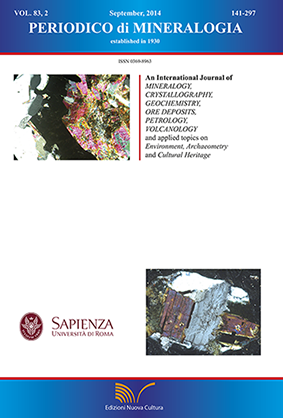Oxidation degree of chromite from Indian ophiolites: a crystal chemical and 57Fe Mössbauer study
DOI:
https://doi.org/10.2451/2014PM0014Keywords:
chromites, single crystal X-ray diffraction, Mössbauer spectroscopy, non-stoichiometry, oxidationAbstract
Several samples of Cr-bearing spinel from Indian ophiolites have been studied by X-ray single crystal diffraction and structure refinement, electron probe microanalyses and Mössbauer spectroscopy. Differences between samples coming from massive chromitite bands and those coming from podiform chromitite deposits have been evidenced: the former have (Mg,Fe)-chromite component ≥ 75%, the latter from 69 to 74%. In both cases the complementary components are aluminate (mainly spinel sensu stricto MgAl2O4). As magnesiochromite (MgCr2O4) is always dominant with respect to chromite (FeCr2O4), the studied samples are classified as magnesiochromite. The multi-analytical approach has revealed that some of the studied spinels are non-stoichiometric (due to Fe2+ oxidation and vacancy formation), with those coming from massive chromitite being more oxidised than those from the pods. Comparison between our results and recent literature suggested that spinel oxidation is more common than usually believed: it is not restricted to ophiolites but may occur in different geological settings and may help reconstructing the complex thermo-oxidative history of the host rock. Consequently, the proposed multi-analytical approach is crucial for an accurate crystal chemical characterisation of spinels and other Fe-bearing mineral phases, especially when geothermobarometric calculations have to be performed.


